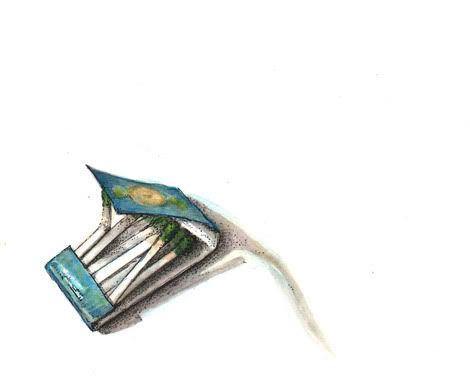In order to ensure I was prepared with how to construct my piece,
Book of Matches, I first settled with working on prototypes towards the final model. I already knew that my 'matches' would be made from cutting pages into columns but I also needed to consider other elements such as arrangement of the matches, building their 'phosphorus' tips, colour and finally how they would be bound as if a book.
As an additional note, we were also required to make note of any concerns for
health & safety while designing and building the book projects.
Since I had a number of second-hand books in possession, there was relative conveniance with materials for prototypes before having to make the final outcome. I took full advantage by using one of the books to start my first test on deciding how the phosphorus tips of the 'matches'.
Both matches on the far left had mod-roc put on the ends and then
painted in acrylic but in different types of paint.
This prototype also showed me a need to have some distance between each match, especially if they were going to be tipped with mod-roc. Regarding the colour, I decided to settle for brighter, solid colours as I felt it would help the piece appropriate from its Pop Art inspired design.
For my second model, I took out a bound collection of pages from another bookset together a limited number of the total pages available. In other words, there would still be pages left unaltered behind the matchstick pages. I also took this time to work on a method for binding the pages entirely.
Shown words from top to bottom: Hotel, Candle, Burning, Kindle
At this point, the reason itself is now lost from any recollection, I also considered marking out certain letters to create words that have some relation to the chosen subject of the book. In this case, all the words made somehow related to a book of matches, matches themselves and often fire. The binding method used for this prototype also seemed effective enough, requiring the very same materials for the construction of the matches.
Step 1 = Right
Step 2 = Left
Step 1:
"
One of the selected books would be split in half, from the binding, after being removed from its covers.
This was done because:
1. More copies could be made from each book.
2. Each book of matches will be at a more appropriate thickness."
Step 2:
"Outline for the matches are drawn on for cutting. The matches are then tipped with mod-roc to represent the phosphorus heads.
Painting:
MATCHES: - Flat colours, as if 'Pop Art' pieces. A vibrant red for phosphorus, the rest in yellow.
BOOK COVERS: - More complex blend of colours to appear like an aged book cover..."
One of the volumes of Book of Matches
























